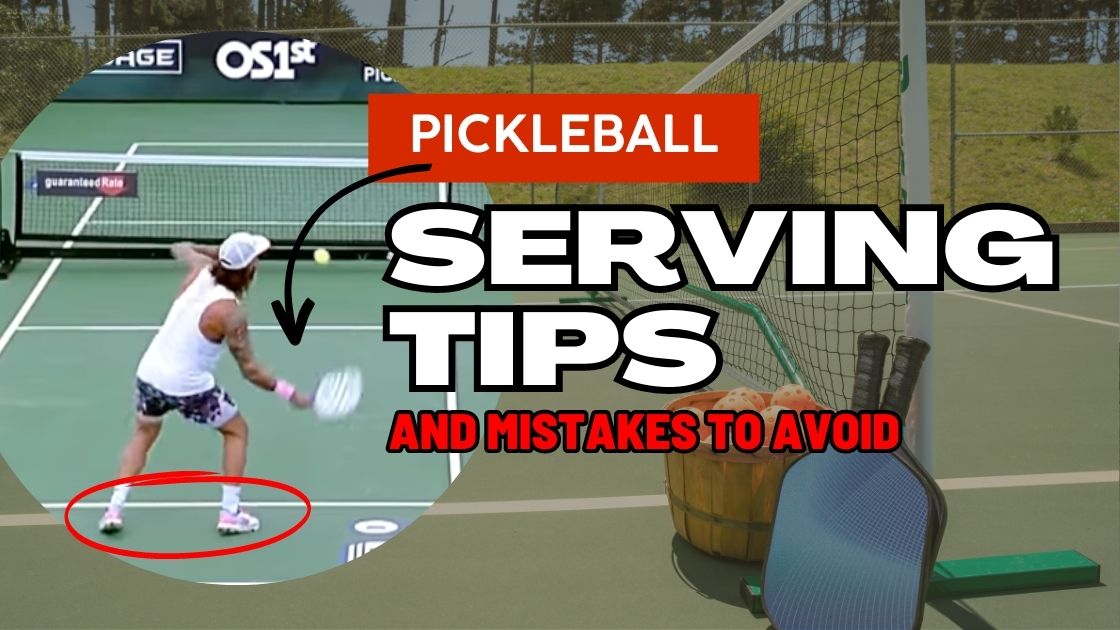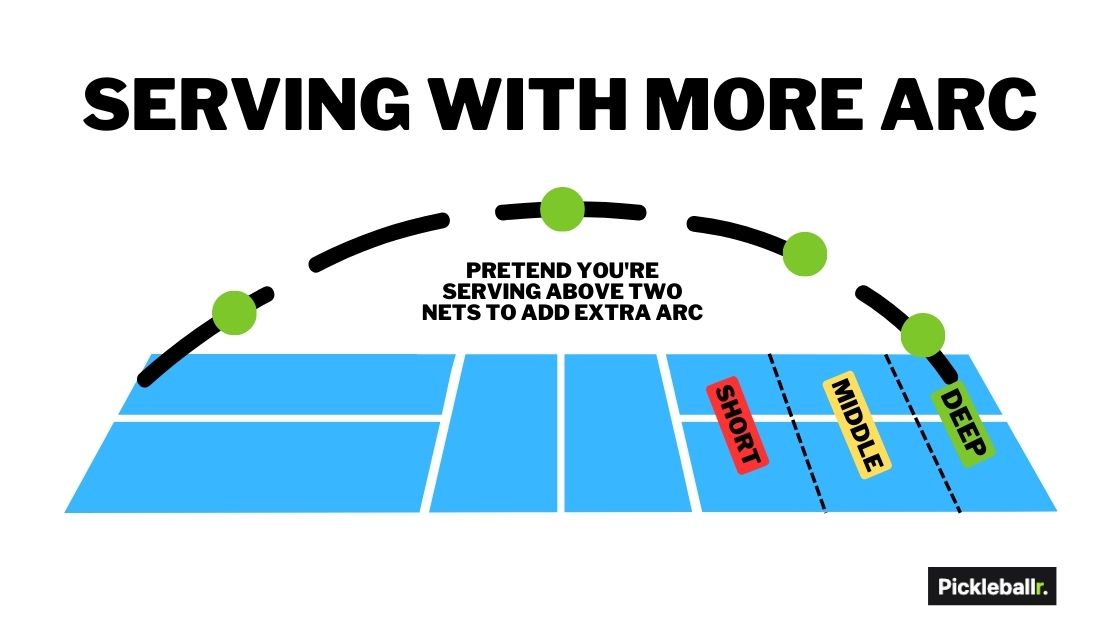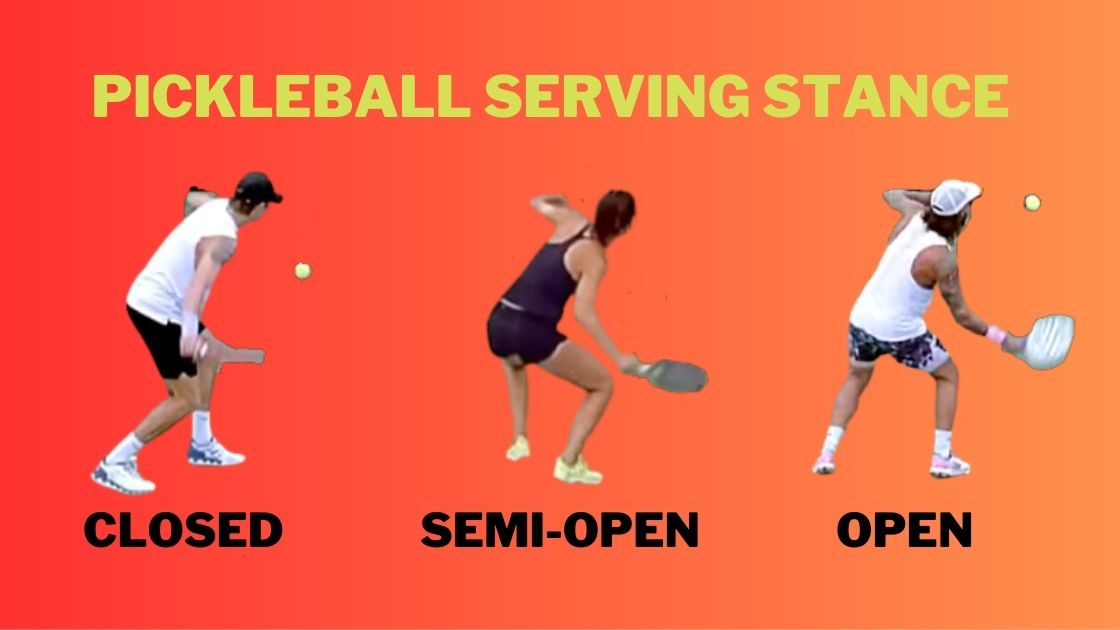
Pickleball Serve Tips
Having a good serve in pickleball can make a significant impact on your game and help you win more matches. To take your serve to the next level, it’s essential to have a plan, know the right techniques, and avoid common mistakes. In this blog post, we’ll explore some top serving tips and discuss the mistakes to watch out for. By implementing these tips, you can bring your serve to the next level and put pressure on your opponents. Let’s dive in!
Table of Contents
- Serve With a Plan
- Serve With More Arc
- Serving Open Stance or Semi-Open
- Serve With Topspin
- Recover After the Serve
- Serving Mistakes
- Conclusion
Pickleball Serving Tips
Serve With a Plan
Having a plan before you serve is an easy way to win more matches and bring your serve to the next level. You should know what your favorite serve is and if you have a better serve on a particular side. There are a list of questions you should be able to answer before each serve.
- Are you going to serve out wide, to the middle, or down the center line?
- Does your opponent have a better forehand or backhand?
- Are they standing closer to one side of the box than the other because they want to hit a certain shot?
- What is the score and can I afford to miss this serve?
Being able to answer these questions will help you determine where and how you’re going to serve the next point. It might sound like overkill to a recreational player, but this type of serving strategy separates the beginners from the rest of the pack.
Serve with More Arc

Another pickleball serving tip is to serve with more arc. Most players start to serve harder as their game improves, thinking this is the best way to get a weak return. While this is true in most cases, better players can handle fast serves without much of a problem.
It is much more difficult to return a serve that lands deep in the service box than a fast serve that lands in the middle of the box. Timing the return becomes much more difficult. This is because the returner has less time to react once the ball has actually bounced on their side of the court. They’ll have to start their swing either before the ball bounces or just as it bounces instead of taking their time and letting the ball bounce first.
An easy way to get more arc on the serve is to pretend you’re playing with two nets stacked on top of each other. This is actually a popular tennis drill where coaches will tie a second net above the normal net to help their students work on their topspin groundstrokes or kick serves. Try aiming higher than you normally would and add extra topspin to help keep the ball in the court. This is a much easier way to get the ball deeper than just trying to serve with more power.
Serving Open Stance or Semi-Open

It’s not uncommon to see professional pickleball players serving with an open or semi-open stance. The main reason for this is that you can generate more power and paddle speed by rotating your hips during the swing. This can be thought of somewhat like a golf swing. If you stayed perfectly sideways during your golf swing and didn’t open your hips, you’d generate less club head speed on contact. The idea is the same with a pickleball serve.
Before moving on, it’s important to know that there are many professionals who serve with a closed stance. Their stance does not negatively impact the overall performance of their serve or cause them to lose more matches. It is simply personal preference to have an open or closed stance and any benefits at the professional level are marginal.
Serve With Topspin
After learning how to serve in pickleball, the next technique to bring it to the next level is to serve with topspin. Topspin will allow you to hit the ball harder while keeping the ball in the court. If you’re an intermediate or advanced player you’ll already be familiar with hitting the ball with topspin.
Adding topspin to the serve will not only allow you to hit harder, but it will also help you improve your accuracy. Once you’ve gotten the hang for serving with topspin, you’ll notice that it becomes a repeatable process and you gain muscle memory. It is much easier to hit the same serve over and over again with topspin than it is when hitting the ball flat.
In order to generate topspin, you’ll want to increase paddle speed from low to high when making contact with the ball. This creates a brushing motion on the back of the ball that causes the forward rotation. You will want to be careful snapping your wrist too much when doing this as you could find yourself hitting an illegal serve. Remember, the paddle cannot be above your wrist when you make contact with the ball.
Recover After the Serve
This might not be an obvious technique to work on since it happens after the serve, but it’s important to recover and prepare for the next shot. We all love to admire a great serve, who doesn’t? But quickly after you’ve hit the serve, it’s time to prepare for the next shot.
After serving you should be moving quickly into a split step to get yourself on balance and ready to explode in any direction. You should try to do this at or behind the baseline since you must let the ball bounce after the return is hit.
Serving Mistakes
Going For too Much
It’s easy to go for too much on the serve. It’s an exciting shot to hit once you get a feel for it, and everybody loves to hit an ace. The problem is, pickleball serving rules say that you only get one chance to make the serve. There are two main ways you can go for too much on the serve.
- Hitting the ball too hard
- Aiming too close to the line
Hitting the ball too hard is the most common way to hit the serve out. This can also happen if you’re trying to hit the ball with a lot of spin. You end up squeezing your paddle too tight and mess up the angle of the paddle face. Instead, try to keep the serve at 80% power. This should be just enough pop to allow you to generate good spin while keeping the ball in the court.
Aiming too close to the line is another easy way to miss your serve. Some players like to cheat to one side on their return and bait the server to serve to one side. This is a good strategy for the returner since it puts pressure on the server, especially at the intermediate level. It’s important to not let this shake your confidence when you’re serving.
Having a consistent and rock solid serve that you and your partner can rely on with help you win more matches. Don’t forget, medium speed serve that is deep and to the middle is very effective.
Complicated Service Motion
If you’ve ever seen someone with a complicated golf swing, you’ll wonder how they ever hit the ball in the first place. The same thing applies to pickleball serves. Most of the time, the complicated service motion happens during their backswing and is typically referred to as a hitch.
Some players like to bring the paddle back before they toss rather than keeping the paddle and ball closer together at the start of the service motion. This can hurt momentum and paddle speed, but is sometimes necessary for players or are struggling with the timing on their serve.
If something feels off in your serve or you’re struggling with consistency, it might be time to reassess your swing and make sure it isn’t overly complicated. Less is more in this case. Pickleball serving rules are put in place to keep service motion simple to learn and easy to execute.
Serving Off Balance
Another common mistake players make on the serve is being off balance. Staying on balance during the serve is one of our favorite pickleball tips to share because so many new players struggle with this part of the serve. Sometimes players get stuck with bad serving habits and haven’t had anyone correct them. The most common ways to be off balance on the serve are
- Having an exaggerated open or closed stance
- Shuffling their feet after the toss
- Stepping with the back foot
- Rushing the service motion
Having a comfortable stance is crucial for a good serve. You have three simple choices: closed stance, open stance, or semi-open stance. If you use too much of a closed or open stance, you’ll have to compensate by using more effort with your upper body or adjusting the toss to get the serve in.
As an example, if you’re a right-handed player serving from the right side with a very closed stance, you’ll need to twist your upper body and throw the ball farther away to hit the ball cross court. Using too much of an open stance will make you aim in the wrong direction and throw off your balance when you swing.
Another issue is shuffling your feet after the toss. This is a common issue that new tennis players deal with as well. Try to keep your feet planted with your knees bent during the serve and especially during your toss. If you find yourself taking little steps after you toss, chances are you either have your feel less than shoulder-width apart or you have a wild toss. Widen you stance past shoulder-width and maintain a solid base before tossing.
New players may also have the tendency to step with the back foot when they’re serving. This is different than a professional closed stance service motion like Ben Johns where he serves and rotates around while keeping their front foot planted. An example of this would be where a right-handed player is using an open or semi-open stance and takes a step with their right foot when serving. This is a very easy way to throw yourself off balance during the serve
Rushing the service motion is another mistake that can cause you to serve off balance. Some players quickly walk back to the baseline and serve right away. They might not even check to see if their opponent is ready for the serve. Take your time when you’re preparing for the serve and catch your breath. You should have a plan about where you’re going to serve and what shot you expect to hit next. You should develop an easily repeatable serve prep and service motion.
Conclusion
Having a strong and reliable pickleball serve is a great way to earn free points and win more matches. By having a plan before you serve, adding more arc and depth to the shot, and focusing on a smooth recovery, you can enhance the effectiveness of your serve.
It’s also important to avoid common mistakes such as going for too much, having a complicated service motion, and serving off balance. By removing these bad habits from your serve, you’ll increase the consistency and improve the performance of the serve. So, take the time to get out there and practice your serve, and watch your game reach new heights.